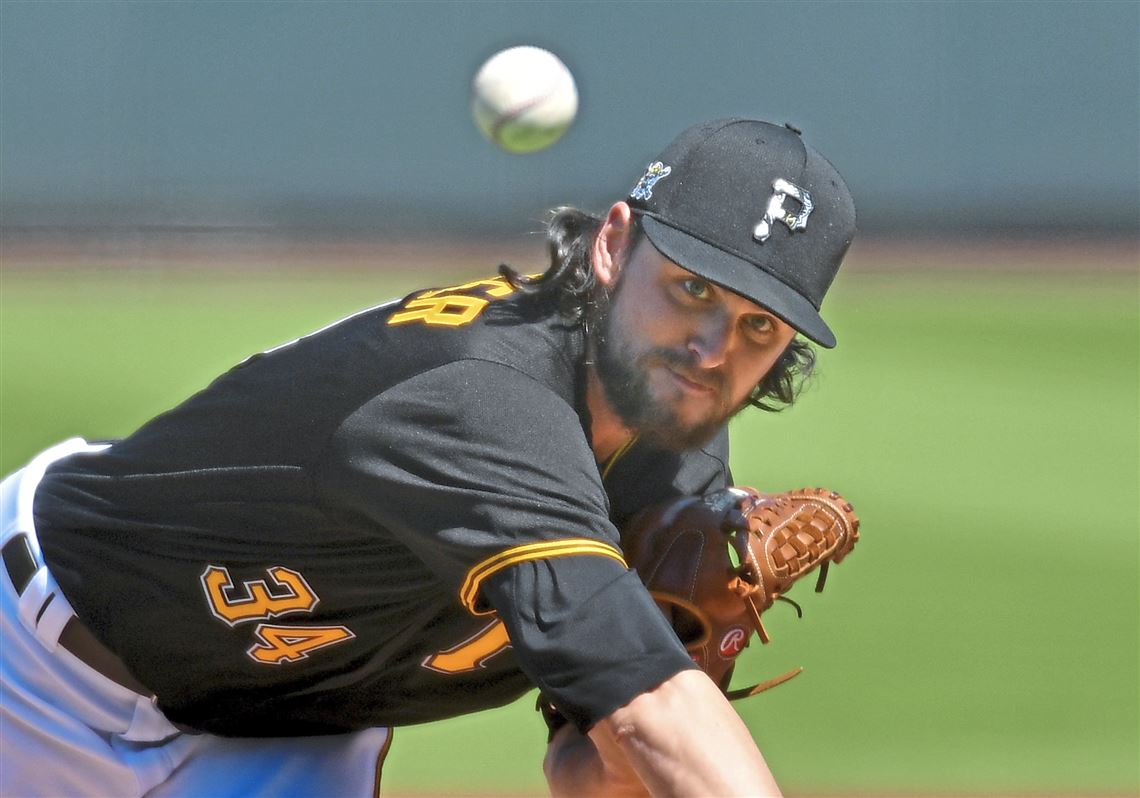BRADENTON, Fla. — It’s not hard to pinpoint how and where the Pirates can most easily improve upon their .317 winning percentage from 2020. It’s the same thing for baseball teams at every level — starting pitching.
Hey, there’s a reason why these guys get paid a lot of money and quality pitching remains the sport’s most valuable currency.
Manager Derek Shelton said earlier this spring that he expects to open the season with a five-man rotation, although general manager Ben Cherington amended that last Friday after signing Trevor Cahill, stating that the Pirates could go with six at various points of the season.
Right now those spots will likely be occupied by some combination of Mitch Keller, Steven Brault, Chad Kuhl, JT Brubaker, Tyler Anderson and Cahill, with the first four contributing to a 13-game stretch at the end of 2020 where Pirates starters surprisingly posted the best ERA (1.94) in Major League Baseball.
It’s obviously impossible to expect that level of performance in 2021. But it’s also reasonable to think those guys could keep the Pirates in games and give them a chance to win if they do other things well — some steady fielding, timely hitting and fundamentally sound baseball.
As a way to examine some of what the Pirates might be looking for out of their starting rotation, we’ve zeroed in on six pitches, one for each guy on this list. Here’s a look at the pitches that could make a difference for that group.
Mitch Keller’s changeup
This one has the tiniest sample size of any pitch on the list, with Keller throwing just 40 of them during his first 16 big league starts. The 24-year-old right-hander has been experimenting with his grip but last season settled on something that most resembles a splitter. He spent the offseason trying to perfect it.
“I feel a lot better with it command-wise,” Keller said. “I’m getting a lot of good action. I’m really excited. One of my goals this year is to use that a lot more. I think it will make my fastball play up. I see it as a really good pitch for me to get some quick and easy outs.”
Keller does not need his changeup to be a swing-and-miss type of offering, but he does need to throw it with conviction, with fastball arm action creating deception.
After a year in which opposing hitters had a weighted on-base average of .203 against his slider and .254 when facing his curveball, Keller’s changeup — and his willingness to throw it — should be a focal point.
By the way, since you’ll see wOBA a lot here, think of it almost as Wins Above Replacement. Weighted on-base average combines all aspects of hitting into one number, weighing them in proportion to their actual run value. It’s a neat and tidy way of expressing a hitter’s success against a certain pitch.
Chad Kuhl’s two-seamer
Kuhl returned from Tommy John surgery in 2020 as a different pitcher, using curveballs and sliders — spin pitches — 52.1% of the time. Meanwhile, Kuhl basically shelved his four-seamer in games, throwing it at a 1.6% clip, down from 22.2% in 2018, his last season before surgery.
If Kuhl is going to pick one of his two fastballs and improve its usage, he’ll need that pitch — likely the two-seamer — to be better than it was in 2020. Throwing two-seamers 42.1% of the time last summer, the pitch had a wOBA of .469, which obviously isn’t very good.
Kuhl’s spin pitches remain excellent, but he risks becoming predictable if he’s not able to use his mid-90s velocity to keep hitters honest.
“I’m just trying to get back to more of a balance, being able to throw the two-seamer more often and more comfortably as a No. 1 thing,” Kuhl said.
Steven Brault’s changeup
The left-hander’s changeup is much different than that of Keller, in that Brault threw it a career-high 24.3% of the time in 2020. With great success, too, as hitters had a meager .138 wOBA against it.
Brault’s four-seam fastball remains a strong pitch, and the deception he gets allows him to lean on it a lot. There’s a reason he threw 69 consecutive heaters in a start against the Rockies on Sept. 1, 2019.
Fastball deception is part of what makes Brault’s changeup so effective. They come out of the same arm slot, with similar action.
And while Brault’s slider is absolutely a quality third option, his changeup has shown the ability to keep exit velocities down (average of just 81.5 mph in 2020) and produce quick outs.
JT Brubaker’s curveball
Similar to Kuhl’s spin stuff, Brubaker has a terrific curveball. The focus for him has been ensuring it doesn’t look too much like his slider, the right-hander occasionally — and accidentally — merging two above-average offerings into one.
This spring, Brubaker said he’s been working on the shape of his curveball and ensuring it maintains enough vertical movement. Too often in the past, Brubaker said he’s been guilty of not staying out in front of the pitch, which can make it more of a slurve with side-to-side break.
“I think it's just my release,” Brubaker said. “I’ve just been working on making sure I stay out in front with it and I don't get too on the side of it.”
Again, Brubaker’s curveball is not on this list because it’s a negative for him. The pitch actually produced a .207 wOBA in 2020, the best of anything he threw. It’s more maintaining the quality of the pitch, so he can possibly throw it more than the 13.7% he used it in 2020.
Tyler Anderson’s cutter
The second left-hander the Pirates expect to have in their rotation looks somewhat similar to Brault in that he’s primarily a four-seam/changeup guy, although Anderson’s third-best pitch comes out of his hand about 2 mph harder than Brault’s slider.
It’s also a pitch Anderson used earlier in his career to great success. While pitching to a mark of 3.2 WAR per Baseball-Reference.com as a rookie in 2016, Anderson’s cutter produced a wOBA of .306, the best of any of his regular offerings back then.
Anderson also threw his cutter 26.2% of the time, though his usage of that pitch dropped to a career-low 18.1% in 2020. One reason for that could be the wOBA of .372 that opposing hitters had against it, which possibly forced Anderson to use other pitches more.
Anderson has thrown a curveball and sinker at various times throughout his career, although their usage has been extremely limited. So for the Pirates to get more out of the southpaw, they need that pitch to return to its previous form, diversifying his pitch mix.
Trevor Cahill’s curveball
When baseball people refer to throwing curveballs as “dropping the hammer,” it’s almost like they had Cahill’s hook in mind. Its spin rate is terrific, and it’s routine for batters to swing right through the terrific pitch.
In 2020, for example, batters had a ridiculous 43.8 whiff percentage on Cahill’s curveball, a nod to its overhand break and deceptive movement. Given how hard it is to hit, it’s actually surprising that Cahill has never thrown it more than 23% in a season, which came last year.
Cahill is not a curveball specialist, as he’s also had a tremendous amount of success over the years with his changeup. At the same time, his most productive seasons have often been tied to his curveball usage and how much of a regular weapon that pitch is for him.
“I definitely started throwing it a lot more last year, especially when I went to the bullpen,” said Cahill, who has bounced between starting and relieving the past handful of years. “When I was in the bullpen, I don't think I threw a fastball my last three outings. It's just one of those things with the numbers, they were like, 'Keep throwing it. It's tough to square up.' So I just kept throwing it.
“Like with anything else, the more you throw it, the more comfortable you are with it.”
Like any good curveball, Cahill’s features a substantial drop from his hardest pitch — the sinker. It’s usually around 11 mph an hour, routinely forcing goofy swings and weak contact when batters are fooled.
Jason Mackey: jmackey@post-gazette.com and Twitter @JMackeyPG.
First Published: March 16, 2021, 10:00 a.m.





















